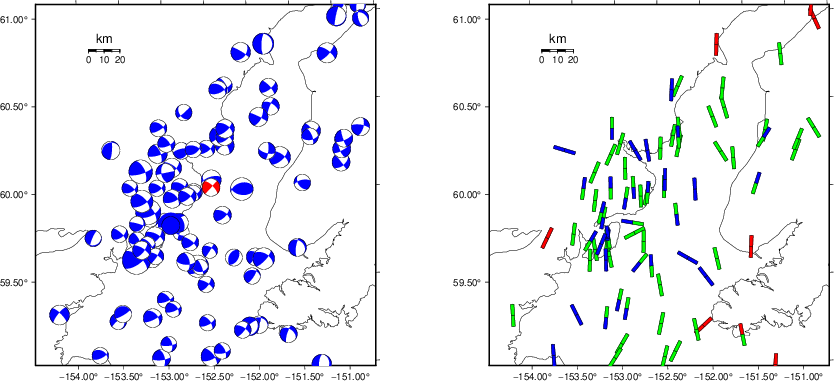Location
Location ANSS
The ANSS event ID is ak0258jwrkyq and the event page is at
https://earthquake.usgs.gov/earthquakes/eventpage/ak0258jwrkyq/executive.
2025/07/05 18:15:07 60.025 -152.475 98.9 4.4 Alaska
Focal Mechanism
USGS/SLU Moment Tensor Solution
ENS 2025/07/05 18:15:07.0 60.03 -152.48 98.9 4.4 Alaska
Stations used:
AK.BAE AK.BRLK AK.CAPN AK.FID AK.FIRE AK.GHO AK.HOM AK.L19K
AK.L22K AK.M20K AK.N18K AK.O18K AK.O19K AK.P17K AK.P23K
AK.PWL AK.Q19K AK.RC01 AK.SAW AK.SKN AK.SLK AK.SWD AT.PMR
AT.TTA AV.ACH AV.RED AV.SPCL AV.STLK II.KDAK
Filtering commands used:
cut o DIST/3.5 -40 o DIST/3.5 +50
rtr
taper w 0.1
hp c 0.03 n 3
lp c 0.10 n 3
Best Fitting Double Couple
Mo = 5.75e+22 dyne-cm
Mw = 4.44
Z = 100 km
Plane Strike Dip Rake
NP1 225 90 -20
NP2 315 70 -180
Principal Axes:
Axis Value Plunge Azimuth
T 5.75e+22 14 272
N 0.00e+00 70 45
P -5.75e+22 14 178
Moment Tensor: (dyne-cm)
Component Value
Mxx -5.41e+22
Mxy 8.38e+15
Mxz 1.39e+22
Myy 5.41e+22
Myz -1.39e+22
Mzz 1.72e+15
--------------
----------------------
----------------------------
###--------------------------#
##########-------------------#####
##############--------------########
#################----------###########
#####################-----##############
#######################--###############
# ####################-#################
# T ##################-----###############
# ################---------#############
##################------------############
###############---------------##########
##############------------------########
###########---------------------######
########-----------------------#####
#####--------------------------###
#-----------------------------
------------- ------------
---------- P ---------
------ -----
Global CMT Convention Moment Tensor:
R T P
1.72e+15 1.39e+22 1.39e+22
1.39e+22 -5.41e+22 -8.38e+15
1.39e+22 -8.38e+15 5.41e+22
Details of the solution is found at
http://www.eas.slu.edu/eqc/eqc_mt/MECH.NA/20250705181507/index.html
|
Preferred Solution
The preferred solution from an analysis of the surface-wave spectral amplitude radiation pattern, waveform inversion or first motion observations is
STK = 225
DIP = 90
RAKE = -20
MW = 4.44
HS = 100.0
The NDK file is 20250705181507.ndk
The waveform inversion is preferred.
Magnitudes
Given the availability of digital waveforms for determination of the moment tensor, this section documents the added processing leading to mLg, if appropriate to the region, and ML by application of the respective IASPEI formulae. As a research study, the linear distance term of the IASPEI formula
for ML is adjusted to remove a linear distance trend in residuals to give a regionally defined ML. The defined ML uses horizontal component recordings, but the same procedure is applied to the vertical components since there may be some interest in vertical component ground motions. Residual plots versus distance may indicate interesting features of ground motion scaling in some distance ranges. A residual plot of the regionalized magnitude is given as a function of distance and azimuth, since data sets may transcend different wave propagation provinces.
ML Magnitude

Left: ML computed using the IASPEI formula for Horizontal components. Center: ML residuals computed using a modified IASPEI formula that accounts for path specific attenuation; the values used for the trimmed mean are indicated. The ML relation used for each figure is given at the bottom of each plot.
Right: Residuals from new relation as a function of distance and azimuth.

Left: ML computed using the IASPEI formula for Vertical components (research). Center: ML residuals computed using a modified IASPEI formula that accounts for path specific attenuation; the values used for the trimmed mean are indicated. The ML relation used for each figure is given at the bottom of each plot.
Right: Residuals from new relation as a function of distance and azimuth.
Context
The left panel of the next figure presents the focal mechanism for this earthquake (red) in the context of other nearby events (blue) in the SLU Moment Tensor Catalog. The right panel shows the inferred direction of maximum compressive stress and the type of faulting (green is strike-slip, red is normal, blue is thrust; oblique is shown by a combination of colors). Thus context plot is useful for assessing the appropriateness of the moment tensor of this event.
Waveform Inversion using wvfgrd96
The focal mechanism was determined using broadband seismic waveforms. The location of the event (star) and the
stations used for (red) the waveform inversion are shown in the next figure.
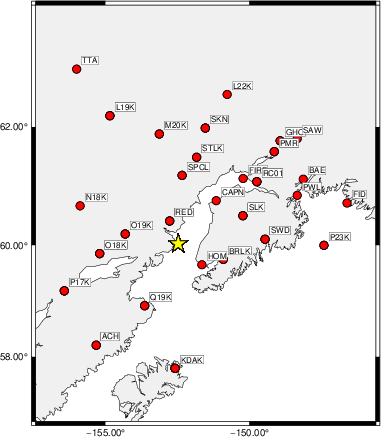
|
|
Location of broadband stations used for waveform inversion
|
The program wvfgrd96 was used with good traces observed at short distance to determine the focal mechanism, depth and seismic moment. This technique requires a high quality signal and well determined velocity model for the Green's functions. To the extent that these are the quality data, this type of mechanism should be preferred over the radiation pattern technique which requires the separate step of defining the pressure and tension quadrants and the correct strike.
The observed and predicted traces are filtered using the following gsac commands:
cut o DIST/3.5 -40 o DIST/3.5 +50
rtr
taper w 0.1
hp c 0.03 n 3
lp c 0.10 n 3
The results of this grid search are as follow:
DEPTH STK DIP RAKE MW FIT
WVFGRD96 2.0 135 90 -5 3.48 0.2363
WVFGRD96 4.0 135 90 -10 3.60 0.2780
WVFGRD96 6.0 315 80 10 3.68 0.2989
WVFGRD96 8.0 315 80 10 3.76 0.3120
WVFGRD96 10.0 315 80 10 3.80 0.3064
WVFGRD96 12.0 130 80 -10 3.83 0.2921
WVFGRD96 14.0 225 80 10 3.86 0.2864
WVFGRD96 16.0 40 85 -15 3.89 0.2841
WVFGRD96 18.0 40 80 -15 3.91 0.2853
WVFGRD96 20.0 40 80 -15 3.94 0.2891
WVFGRD96 22.0 40 90 -30 3.97 0.2954
WVFGRD96 24.0 40 90 -30 3.99 0.3153
WVFGRD96 26.0 40 90 -30 4.02 0.3352
WVFGRD96 28.0 40 90 -30 4.04 0.3517
WVFGRD96 30.0 40 90 -30 4.05 0.3634
WVFGRD96 32.0 40 90 -30 4.07 0.3728
WVFGRD96 34.0 40 90 -25 4.08 0.3771
WVFGRD96 36.0 220 90 20 4.09 0.3809
WVFGRD96 38.0 220 90 15 4.12 0.3853
WVFGRD96 40.0 40 85 -20 4.17 0.3923
WVFGRD96 42.0 40 85 -20 4.20 0.3913
WVFGRD96 44.0 40 90 -15 4.21 0.3898
WVFGRD96 46.0 220 85 15 4.23 0.3898
WVFGRD96 48.0 220 80 5 4.25 0.3925
WVFGRD96 50.0 220 80 -5 4.26 0.3967
WVFGRD96 52.0 220 80 -10 4.28 0.4042
WVFGRD96 54.0 220 80 -10 4.30 0.4139
WVFGRD96 56.0 225 85 -15 4.32 0.4258
WVFGRD96 58.0 225 85 -15 4.33 0.4388
WVFGRD96 60.0 225 85 -15 4.34 0.4514
WVFGRD96 62.0 225 85 -20 4.35 0.4647
WVFGRD96 64.0 225 85 -20 4.36 0.4783
WVFGRD96 66.0 225 85 -20 4.37 0.4917
WVFGRD96 68.0 225 85 -20 4.38 0.5034
WVFGRD96 70.0 225 85 -20 4.39 0.5151
WVFGRD96 72.0 225 85 -20 4.39 0.5250
WVFGRD96 74.0 225 85 -20 4.40 0.5338
WVFGRD96 76.0 45 90 20 4.40 0.5402
WVFGRD96 78.0 45 90 20 4.41 0.5472
WVFGRD96 80.0 45 90 20 4.41 0.5524
WVFGRD96 82.0 45 90 20 4.41 0.5565
WVFGRD96 84.0 45 90 20 4.42 0.5613
WVFGRD96 86.0 45 90 20 4.42 0.5653
WVFGRD96 88.0 45 90 20 4.43 0.5694
WVFGRD96 90.0 45 90 20 4.43 0.5718
WVFGRD96 92.0 45 90 20 4.43 0.5738
WVFGRD96 94.0 225 90 -20 4.43 0.5753
WVFGRD96 96.0 45 90 20 4.44 0.5765
WVFGRD96 98.0 45 90 20 4.44 0.5768
WVFGRD96 100.0 225 90 -20 4.44 0.5769
WVFGRD96 102.0 45 90 20 4.45 0.5761
WVFGRD96 104.0 45 90 20 4.45 0.5752
WVFGRD96 106.0 45 90 15 4.45 0.5741
WVFGRD96 108.0 45 90 15 4.45 0.5716
WVFGRD96 110.0 45 90 15 4.46 0.5712
WVFGRD96 112.0 45 90 15 4.46 0.5702
WVFGRD96 114.0 225 90 -15 4.46 0.5691
WVFGRD96 116.0 45 90 15 4.46 0.5670
WVFGRD96 118.0 45 90 15 4.46 0.5644
WVFGRD96 120.0 45 90 15 4.47 0.5604
WVFGRD96 122.0 45 90 15 4.47 0.5581
WVFGRD96 124.0 45 90 15 4.47 0.5567
WVFGRD96 126.0 45 90 15 4.47 0.5544
WVFGRD96 128.0 225 90 -15 4.48 0.5509
WVFGRD96 130.0 45 90 15 4.48 0.5467
WVFGRD96 132.0 45 90 15 4.48 0.5443
WVFGRD96 134.0 45 80 25 4.48 0.5429
WVFGRD96 136.0 45 80 25 4.48 0.5393
WVFGRD96 138.0 45 80 25 4.48 0.5370
WVFGRD96 140.0 225 90 -15 4.49 0.5322
WVFGRD96 142.0 45 80 25 4.48 0.5336
WVFGRD96 144.0 45 80 25 4.48 0.5297
WVFGRD96 146.0 45 80 25 4.49 0.5292
WVFGRD96 148.0 45 80 25 4.49 0.5264
The best solution is
WVFGRD96 100.0 225 90 -20 4.44 0.5769
The mechanism corresponding to the best fit is
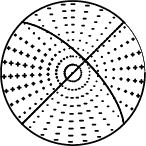
|
|
Figure 1. Waveform inversion focal mechanism
|
The best fit as a function of depth is given in the following figure:
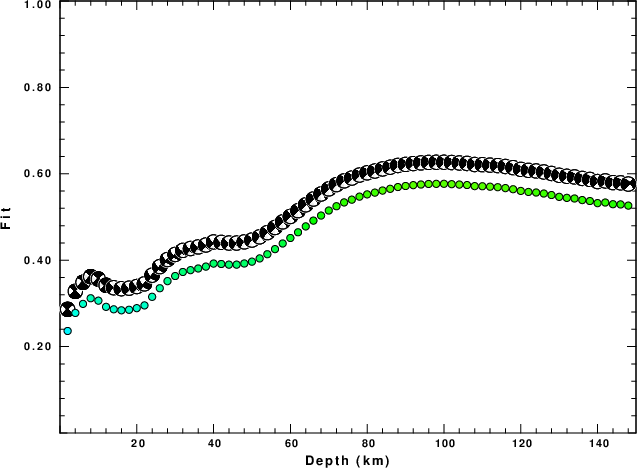
|
|
Figure 2. Depth sensitivity for waveform mechanism
|
The comparison of the observed and predicted waveforms is given in the next figure. The red traces are the observed and the blue are the predicted.
Each observed-predicted component is plotted to the same scale and peak amplitudes are indicated by the numbers to the left of each trace. A pair of numbers is given in black at the right of each predicted traces. The upper number it the time shift required for maximum correlation between the observed and predicted traces. This time shift is required because the synthetics are not computed at exactly the same distance as the observed, the velocity model used in the predictions may not be perfect and the epicentral parameters may be be off.
A positive time shift indicates that the prediction is too fast and should be delayed to match the observed trace (shift to the right in this figure). A negative value indicates that the prediction is too slow. The lower number gives the percentage of variance reduction to characterize the individual goodness of fit (100% indicates a perfect fit).
The bandpass filter used in the processing and for the display was
cut o DIST/3.5 -40 o DIST/3.5 +50
rtr
taper w 0.1
hp c 0.03 n 3
lp c 0.10 n 3

|
|
Figure 3. Waveform comparison for selected depth. Red: observed; Blue - predicted. The time shift with respect to the model prediction is indicated. The percent of fit is also indicated. The time scale is relative to the first trace sample.
|
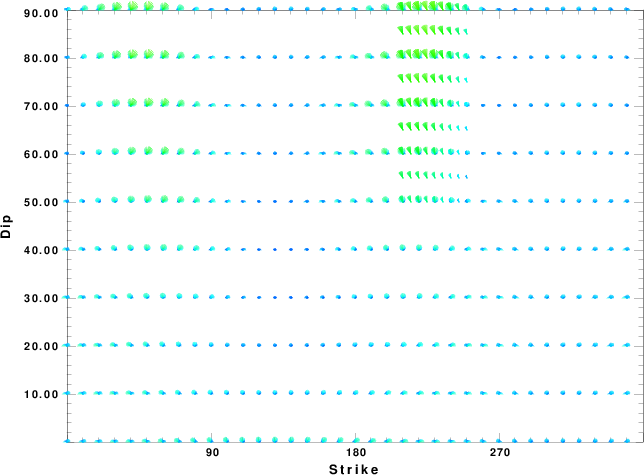
|
|
Focal mechanism sensitivity at the preferred depth. The red color indicates a very good fit to the waveforms.
Each solution is plotted as a vector at a given value of strike and dip with the angle of the vector representing the rake angle, measured, with respect to the upward vertical (N) in the figure.
|
A check on the assumed source location is possible by looking at the time shifts between the observed and predicted traces. The time shifts for waveform matching arise for several reasons:
- The origin time and epicentral distance are incorrect
- The velocity model used for the inversion is incorrect
- The velocity model used to define the P-arrival time is not the
same as the velocity model used for the waveform inversion
(assuming that the initial trace alignment is based on the
P arrival time)
Assuming only a mislocation, the time shifts are fit to a functional form:
Time_shift = A + B cos Azimuth + C Sin Azimuth
The time shifts for this inversion lead to the next figure:
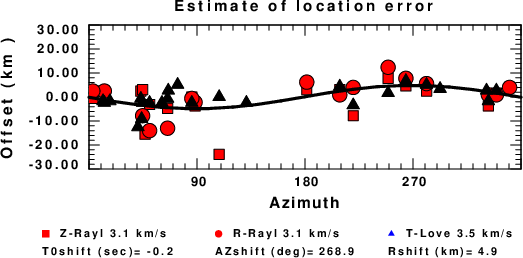
The derived shift in origin time and epicentral coordinates are given at the bottom of the figure.
Velocity Model
The WUS.model used for the waveform synthetic seismograms and for the surface wave eigenfunctions and dispersion is as follows
(The format is in the model96 format of Computer Programs in Seismology).
MODEL.01
Model after 8 iterations
ISOTROPIC
KGS
FLAT EARTH
1-D
CONSTANT VELOCITY
LINE08
LINE09
LINE10
LINE11
H(KM) VP(KM/S) VS(KM/S) RHO(GM/CC) QP QS ETAP ETAS FREFP FREFS
1.9000 3.4065 2.0089 2.2150 0.302E-02 0.679E-02 0.00 0.00 1.00 1.00
6.1000 5.5445 3.2953 2.6089 0.349E-02 0.784E-02 0.00 0.00 1.00 1.00
13.0000 6.2708 3.7396 2.7812 0.212E-02 0.476E-02 0.00 0.00 1.00 1.00
19.0000 6.4075 3.7680 2.8223 0.111E-02 0.249E-02 0.00 0.00 1.00 1.00
0.0000 7.9000 4.6200 3.2760 0.164E-10 0.370E-10 0.00 0.00 1.00 1.00
Last Changed Sat Jul 5 16:13:52 CDT 2025


